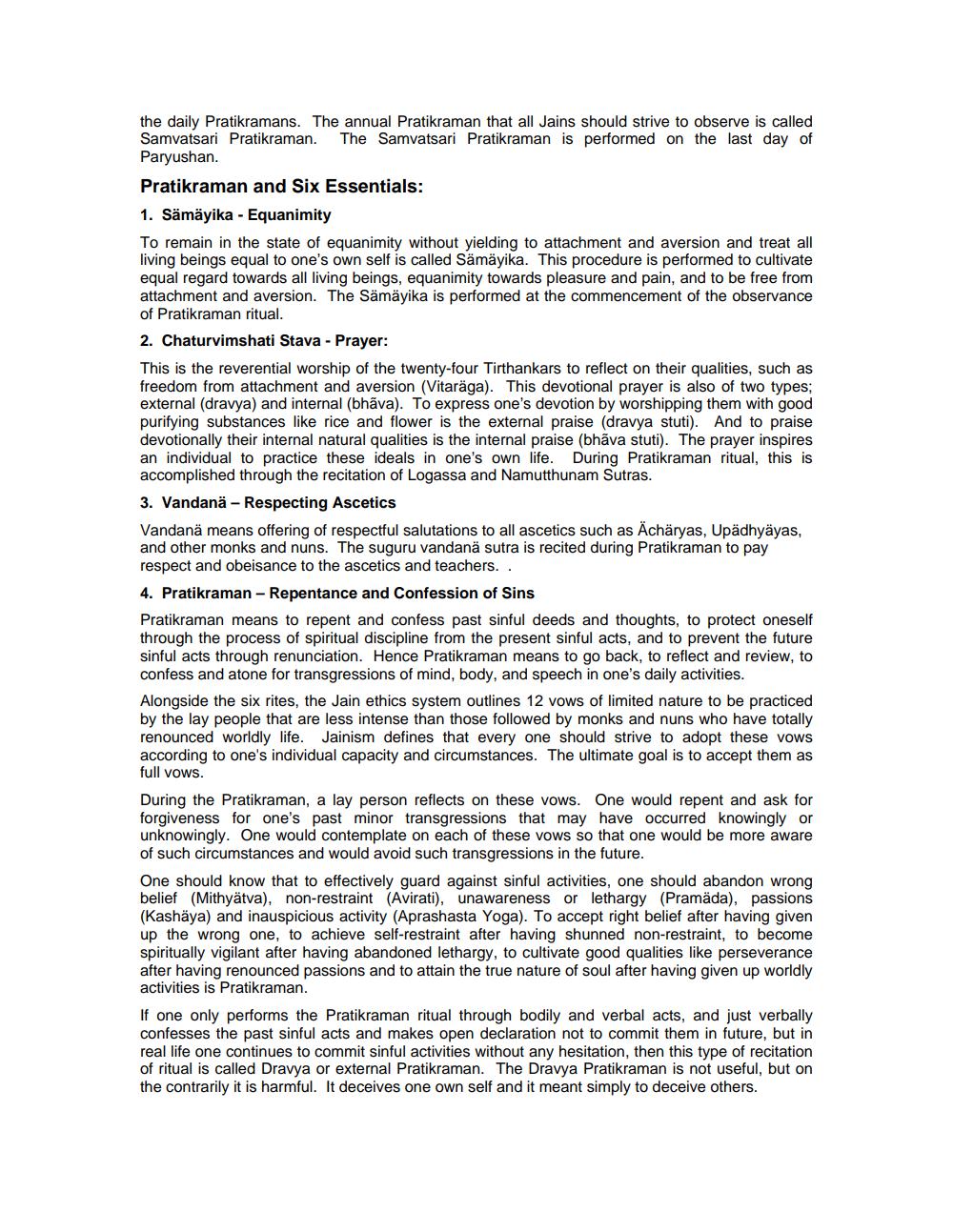Book Title: Pratikraman - Observance of Self Reflection Author(s): Pravin K Shah Publisher: JAINA Education Committee View full book textPage 2
________________ the daily Pratikramans. The annual Pratikraman that all Jains should strive to observe is called Samvatsari Pratikraman. The Samvatsari Pratikraman is performed on the last day of Paryushan. Pratikraman and Six Essentials: 1. Sämäyika - Equanimity To remain in the state of equanimity without yielding to attachment and aversion and treat all living beings equal to one's own self is called Sämäyika. This procedure is performed to cultivate equal regard towards all living beings, equanimity towards pleasure and pain, and to be free from attachment and aversion. The Sämäyika is performed at the commencement of the observance of Pratikraman ritual. 2. Chaturvimshati Stava - Prayer: This is the reverential worship of the twenty-four Tirthankars to reflect on their qualities, such as freedom from attachment and aversion (Vitaraga). This devotional prayer is also of two types; external (dravya) and internal (bhāva). To express one's devotion by worshipping them with good purifying substances like rice and flower is the external praise (dravya stuti). And to praise devotionally their internal natural qualities is the internal praise (bhāva stuti). The prayer inspires an individual to practice these ideals in one's own life. During Pratikraman ritual, this is accomplished through the recitation of Logassa and Namutthunam Sutras. 3. Vandana - Respecting Ascetics Vandana means offering of respectful salutations to all ascetics such as Ächäryas, Upadhyayas, and other monks and nuns. The suguru vandanä sutra is recited during Pratikraman to pay respect and obeisance to the ascetics and teachers.. 4. Pratikraman - Repentance and Confession of Sins Pratikraman means to repent and confess past sinful deeds and thoughts, to protect oneself through the process of spiritual discipline from the present sinful acts, and to prevent the future sinful acts through renunciation. Hence Pratikraman means to go back, to reflect and review, to confess and atone for transgressions of mind, body, and speech in one's daily activities. Alongside the six rites, the Jain ethics system outlines 12 vows of limited nature to be practiced by the lay people that are less intense than those followed by monks and nuns who have totally renounced worldly life. Jainism defines that every one should strive to adopt these vows according to one's individual capacity and circumstances. The ultimate goal is to accept them as full vows. During the Pratikraman, a lay person reflects on these vows. One would repent and ask for forgiveness for one's past minor transgressions that may have occurred knowingly or unknowingly. One would contemplate on each of these vows so that one would be more aware of such circumstances and would avoid such transgressions in the future. One should know that to effectively guard against sinful activities, one should abandon wrong belief (Mithyätva), non-restraint (Avirati), unawareness or lethargy (Pramäda), passions (Kashäya) and inauspicious activity (Aprashasta Yoga). To accept right belief after having given up the wrong one, to achieve self-restraint after having shunned non-restraint, to become spiritually vigilant after having abandoned lethargy, to cultivate good qualities like perseverance after having renounced passions and to attain the true nature of soul after having given up worldly activities is Pratikraman. If one only performs the Pratikraman ritual through bodily and verbal acts, and just verbally confesses the past sinful acts and makes open declaration not to commit them in future, but in real life one continues to commit sinful activities without any hesitation, then this type of recitation of ritual is called Dravya or external Pratikraman. The Dravya Pratikraman is not useful, but on the contrarily it is harmful. It deceives one own self and it meant simply to deceive others.Page Navigation
1 2 3 4
